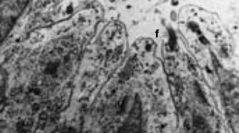

 Zoosystema
22 (2) - Pages 355-368
Zoosystema
22 (2) - Pages 355-368Embryogenesis of Halisarca dujardini from the White Sea (Russia) was studied by light and transmission electron microscopy. The cleavage is equal and asynchronous. From the stage of 8-16 blastomeres, the cells divide perpendicularly to the surface of embryos and form a coeloblastula. The few internal cells of the prelarva are derived by multipolar migration of external cells. The larva (disphaerula) consists of two flagellated spheres: external and internal. The internal sphere is formed by invagination of lateral flagellated cells. The disphaerula is completely flagellated, but the flagella on posterior pole are sparse. The peculiarities of Halisarca embryonic development indicates the particular position of this genus in subclass Ceractinomorpha. The pattern of development is most primitive in this subclass.
Embryonic development, Halisarca dujardini, ultrastructure, cleavage, blastula, morphogenesis, larvae, comparative embryology, Porifera.